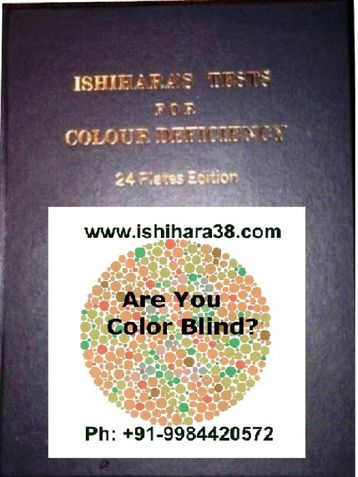You can access the distribution details by navigating to My pre-printed books > Distribution
Ishihara Test Chart Book 24 Plates (eBook)
Designed as a Test for Color Deficiency
Description
The Ishihara test is a color perception test for red-green color deficiencies, the first in a class of successful color vision tests called pseudo-isochromatic plates ("PIP"). It was named after its designer, Dr. Shinobu Ishihara, a professor at the University of Tokyo, who first published his tests in 1917.
The test consists of a number of colored plates, called Ishihara plates, each of which contains a circle of dots appearing randomized in color and size Within the pattern are dots which form a number or shape clearly visible to those with normal color vision, and invisible, or difficult to see, to those with a red-green color vision defect. Other plates are intentionally designed to reveal numbers only to those with a red/green color vision deficiency, and be invisible to those with normal red/green color vision. The full test consists of 38 plates, but the existence of a severe deficiency is usually apparent after only a few plates. There is also an Ishihara test consisting 10, 14 or 24 test plates.
100 Occupations where employers may require verified normal color, or, at least, verified color vision testing
*. Aerial Photographer
*. Clinical Lab Technician
*. Dry Cleaning Spotter
*. Maintenance Service Worker
*. Railroad Conductor
*. Air Conditioner Installer/Mechanic
*. Clothing Sales
*. Editor/Report Production Assistant
*. Mapmakers
*. Railway Mechanic
*. Air Traffic Controllers
*. Color Photographer
*. Electrician
*. Meat Inspector
*. Registered Nurse
*. Aircraft Navigator
*. Color Printing Press Operator
*. Electronics Assembler
*. Military (Many job descriptions)
*. Sanitation Specialist
*. Aircraft Pilot
*. Commercial Printer
*. Electronics Technician
*. Military Engineer
*. School Bus Drivers
*. Animal Code Enforcement
*. Communications Operator
*. Emergency Medical Technicians
*. Military Pilot
*. Shipping and Receiving Clerk
*. Applications/Quality Control Specialist
*. Communications Technician
*. Engineering Technician
*. Network Systems Administrator
*. Software Engineer (Some types)
*. Art Teacher
*. Computer Service Technician
*. Environmental Engineer
*. Non-Destructive Inspector
*. State Park Ranger
*. Auto Body/Painting Technician
*. Court Judicial Assistant
*. Farm Products Grading Inspector
*. Nurse’s Aides
*. State Trooper
*. Biomedical Equipment Technician
*. Court Reporter
* and many more
*. Paint Sales
*. Street Lighting Technician
*. Border Patrol Agent
*. Criminal Lab Technician
*. Firefighters
*. Painter
*. Teachers (Some positions)
*. Building Inspector
*. Customs Officer
*. Freight Conductor
*. Paramedic
*. Transit Department Secretary
*. Building Plans Examiner
*. Dairy Grader
*. Game Warden
*. Pharmacist
*. Transit Vehicle Electronic Technician
*. Bus Driver
*. DEA Special Agent
*. Graphic Artist
*. Pharmacy Technician
*. Transportation Security Screener
*. Buyer for Department Store
*. Dental Lab Technician
*. Graphic Designer
*. Photographic Processor
*. TV Programming Director
*. CAD Operators
*. Dentist
*. Hazardous Materials Technician
*. Police Officer
*. Vehicle Maintenance Supervisor
*. Carpet Sales
*. Deputy Sheriff
*. Highway Patrolman
*. Prison Corrections Officer
*. Wall Covering Sales
*. Civil Aviation Engineer
*. Deputy U.S. Marshal
*. IRS Special Agent
*. Produce Inspector
*. Warehouse Worker/Driver
*. Civil Aviation Mechanic
*. Digital Image Librarian
*. Lifeguards
*. Professional Truck Drivers
*. Weather Analysts
*. Civil Service (Some positions)
*. Drapery Sales
*. Location Specialist
*. Quality Control Specialist
**. Youth Program Director
About the Authors
Book Details
Ratings & Reviews

Currently there are no reviews available for this book.
Be the first one to write a review for the book Ishihara Test Chart Book 24 Plates.
Other Books in Medicine & Science
Dr J R Patel
Priya Sadawarte
Anshu Maheshwari
Bhumi G Patel, Pratyusha Sinha, Drashti Bhavsar




